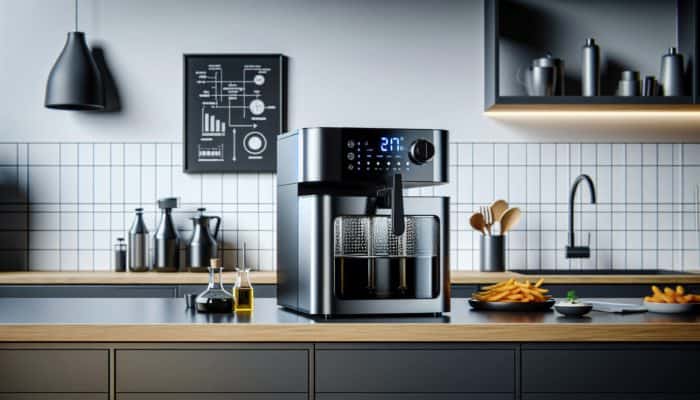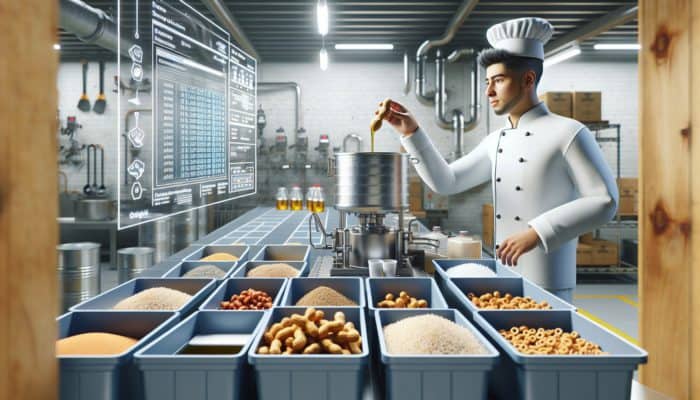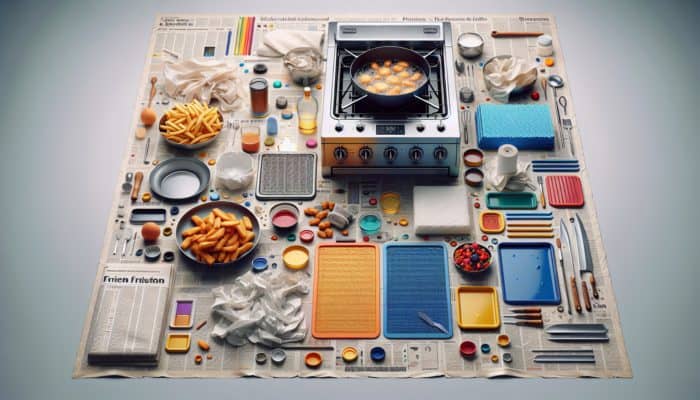Elevate Your Kitchen Skills: Choosing the Best Deep Frying Equipment
Find the Perfect Deep Fryer for Impeccable Cooking Results

Selecting the ideal deep fryer is crucial for fostering a cooking atmosphere that optimizes both taste and cleanliness. A top-tier deep fryer is typically packed with an array of features that enhance your culinary experience. First and foremost, seek out models that feature oil filtration systems, which help preserve oil quality across multiple frying sessions. Moreover, splatter shields are indispensable for controlling messes while cooking, and non-stick surfaces greatly simplify the cleaning process. Additionally, temperature controls enable you to maintain precise cooking conditions, ensuring your dishes are perfectly prepared. Other important features to evaluate include:
- Capacity: Choose a size that aligns with your cooking needs, making sure it can handle the volume of food you plan to fry.
- Ease of Cleaning: Opt for fryers that include removable parts for quick and easy cleaning.
- Safety Features: Confirm that the fryer includes safety features such as cool-touch handles and automatic shut-off capabilities to enhance user safety and prevent accidents.
- Versatility: Some fryers offer extra functions, like steaming or sautéing, which expand their usefulness across different cooking techniques.
By investing in a fryer equipped with these beneficial features, you will significantly improve your deep frying experience, making it both more enjoyable and cleaner for you and your loved ones.
Boosting Deep Frying Efficiency with Suitable Pots and Pans
In the absence of a dedicated deep fryer, many pots and pans can serve as effective alternatives for deep frying. Choose pots made from materials such as cast iron, which is renowned for its remarkable heat retention properties, or stainless steel, known for its durability and high-temperature resistance. It is essential to select a pot that is deep enough to accommodate a generous amount of oil, thus preventing overflow during the frying process.
The dimensions of your pot play a significant role in your frying success; a larger surface area allows for the simultaneous frying of more food, thereby cutting down on cooking time and reducing splatter. Dutch ovens stand out due to their sturdy construction, which helps maintain consistent temperatures throughout the cooking process. Before using any pots or pans, ensure they are completely dry and clean; any residual moisture can result in hazardous splattering and disrupt the frying process.
Essential Accessories for a Mess-Free Deep Frying Experience
Utilizing the appropriate accessories is critical for minimizing mess during the deep-frying process. A thermometer is an essential tool for tracking oil temperature, ensuring it remains consistent and preventing splattering caused by incorrect heat levels. Fry baskets help facilitate the safe lowering and retrieval of food, while splatter screens effectively guard your kitchen against oil sprays.
These tools not only assist in maintaining cleanliness but also enhance the overall frying procedure. For example, using a thermometer can help avoid overheating, while a splatter screen captures any errant droplets. Equipping yourself with these key accessories can revolutionize your cooking process, making it significantly more manageable and enjoyable.
Effectively Managing Oil for Safe and Efficient Deep Frying

Effective oil management is vital for ensuring both safety and efficiency during the deep-frying process. Choosing the right type of oil can enhance flavor while minimizing mess. Opt for oils with high smoke points, such as peanut oil or canola oil, as they can tolerate high temperatures without breaking down, resulting in a cleaner frying experience.
In addition, it is crucial to maintain your oil by filtering it after every use to eliminate food particles that can impart unpleasant flavors and odors. When it comes to disposal, never pour oil down the drain; instead, store it in a sealed container and take it to a recycling center whenever possible. Responsible oil management not only enhances your cooking experience but also contributes to a more sustainable kitchen by reducing waste.
Optimizing Your Cooking Space for Peak Deep Frying Efficiency
Creating a Clean Cooking Environment for Successful Deep Frying
Establishing a tidy and organized workspace is essential for minimizing mess during the deep-frying process. Start by clearing your area of unnecessary items and ensuring you have a designated space for all cooking tasks. Keep paper towels and cleaning supplies within easy reach to quickly address any spills that may occur while frying.
Before you begin, arrange all your necessary tools and ingredients to reduce the chance of knocking over items or creating unnecessary messes. By decluttering surfaces and strategically positioning your tools, you can maintain focus and enjoy the frying experience without feeling overwhelmed by potential chaos. An organized workspace not only increases efficiency but also enhances the overall enjoyment of your cooking experience.
Implementing Protective Measures During Deep Frying

Utilizing protective coverings is a clever method for capturing oil splatters and keeping your workspace tidy while frying. Consider using materials like newspaper, which can be easily discarded, or silicone mats that are easily cleaned and reused. These materials serve as effective barriers against splashes, helping to protect your counters and stovetops from oil stains.
Additionally, you can employ old towels or baking sheets to catch any drips or spills, significantly simplifying the cleanup process. Having these protective layers in place not only maintains a neat space but also saves you time when tidying up after cooking, allowing you to relish your meal without the stress of a messy kitchen.
Organizing Your Cooking Tools for Easy Accessibility
Having all necessary tools readily accessible can greatly minimize mess while cooking. Designate a specific location for each item, ensuring you know exactly where to locate them when needed. This strategy avoids unnecessary movements around your workspace, which could lead to accidental spills and messes.
Consider using a caddy for utensils or small containers for spices and seasonings. This organizational approach streamlines your workflow, lowering the likelihood of mishaps. A well-organized kitchen not only fosters efficiency but also enhances your deep-frying experience, making it more enjoyable and less chaotic.
Expert Techniques for Deep-Frying with Minimal Mess
Insights from Professional Chefs on Clean Deep-Frying Practices
Professional chefs offer valuable advice for keeping a clean kitchen while deep-frying. A common tip is to ensure the oil is at the correct temperature before introducing any food, as this significantly reduces splattering. Chefs highly recommend using a thermometer to accurately track oil temperature.
Many chefs also utilize deep-fry baskets for the easy placement and retrieval of food, which helps prevent oil from spilling over. They often stress the importance of preparation; by having all components prepped and ready, they maintain a tidy workspace. For example, a well-known chef shared how a splatter screen saved time while frying fish, as it greatly reduced the necessary cleanup afterward.
Understanding the Science Behind Oil to Reduce Mess
Gaining a deeper insight into the science of oil behavior is essential for effectively minimizing mess when deep-frying. For instance, the temperature of the oil directly impacts its volatility and likelihood to splatter. When oil is heated beyond its ideal level, it can bubble aggressively, leading to splatters. Conversely, oil that is too cool will absorb food, failing to achieve the desired crispy texture.
Maintaining the correct oil temperature, typically between 350°F and 375°F (175°C to 190°C), is vital for achieving optimal results. Regularly check the temperature with a thermometer to ensure ideal frying conditions. When the oil temperature remains stable, it behaves in a way that significantly reduces the chances of splattering, resulting in a cleaner cooking experience.
Implementing Safety Precautions for a Secure Deep Frying Experience
Safety is paramount when deep-frying, and adhering to certain precautions can help prevent accidents and mess. First and foremost, ensure that all equipment is dry and clean before use; moisture can lead to dangerous splattering. Always use long-handled utensils to maintain a safe distance from hot oil and avoid burns.
Furthermore, it is crucial to keep children and pets away from the frying area, as hot oil can cause serious injuries. An additional safety measure is to have a fire extinguisher readily available, specifically rated for grease fires. Being prepared not only keeps your kitchen clean but also creates a safe cooking environment.
Essential Tools for a Mess-Free Deep Frying Experience
Experts suggest specific tools and equipment designed to minimize mess during deep-frying. A high-quality splatter screen can effectively shield surrounding surfaces, while an integrated oil filtration system in a deep fryer can help maintain oil clarity and reduce residue accumulation.
Additionally, consider investing in a digital fryer with programmable settings. These fryers often come equipped with built-in timers and temperature controls, allowing for precise cooking and significantly reducing the risk of oil overflow. When armed with the right tools, deep-frying can be a neat and enjoyable culinary process.
Effective Cleaning Techniques for Post-Frying Hygiene
Cleaning up after deep-frying is crucial for managing and minimizing mess in the kitchen. Start by responsibly disposing of any used oil; do not leave it in the fryer, as it can harden and become difficult to clean. Use a metal strainer to filter out food particles from the oil before storing or disposing of it.
For cleaning surfaces, a mixture of warm soapy water and a scrubbing brush is highly effective. Additionally, a degreaser can be beneficial for tackling stubborn oil stains on countertops or stovetops. Regular maintenance and effective cleaning practices will ensure that your kitchen remains hygienic and tidy following deep-frying, creating a pleasant cooking environment.
Strategies for Minimizing Oil Splatter During Deep Frying
Maintaining Optimal Oil Temperature to Reduce Splatter
Maintaining the correct oil temperature is essential for minimizing splatter during deep-frying. Start by gradually heating the oil; sudden temperature changes can lead to dangerous splattering. Follow these steps to achieve and maintain the right oil temperature:
- Select the Right Pot: Use a deep, heavy pot to ensure even heating.
- Use a Thermometer: Always monitor the oil temperature for accuracy.
- Heat Gradually: Slowly increase the heat to prevent overheating.
- Test with a Small Piece of Food: Drop in a small piece to check if the oil is ready.
By adhering to these guidelines, you can ensure the oil remains stable, significantly reducing the likelihood of splatter and mess during the frying process.
How to Carefully Place Food to Minimize Oil Splashing
How you introduce food into the oil can greatly influence splattering. Instead of dropping food carelessly, gently lower it into the oil using a slotted spoon or basket. This technique allows for controlled immersion, thereby minimizing disturbance in the oil.
Aim for a slow, steady motion, ensuring the food is fully submerged before releasing it. This method prevents the oil from erupting when it makes contact with cold food, reducing splatter and potential hazards. Practicing careful food placement can significantly improve your deep-frying experience and keep your cooking area cleaner.
The Importance of Thoroughly Drying Food Before Frying
Excess moisture on food can dramatically cause oil to splatter during frying. To ensure a clean frying experience, it is vital to thoroughly dry food before immersing it in the oil. Techniques such as patting with paper towels or using a salad spinner for vegetables can effectively eliminate moisture.
For items like chicken, consider allowing them to air-dry for a short period after seasoning. This practice not only reduces splatter but also contributes to achieving a crispier texture. Ensuring your food is adequately dried is a key step in successful deep-frying, enhancing both safety and quality in your cooking.
Recognizing the Benefits of Using Less Oil in Cooking
Health Advantages of Reducing Oil Usage in Cooking
Utilizing less oil during deep-frying can lead to healthier meals with significantly lower calorie content. Foods fried in excess oil tend to absorb more fat, resulting in higher calorie counts and less favorable nutritional profiles. By opting to use less oil, you can create dishes that are lighter and more heart-healthy, aligning with modern dietary preferences.
Moreover, using less oil can prevent the formation of harmful compounds that may develop when oil is reused multiple times. By prioritizing healthier cooking methods, you not only enhance the nutritional quality of your meals but also create dishes that are more appealing to health-conscious diners.
Financial Benefits of Reducing Oil Usage
Utilizing less oil can result in significant financial savings over time. High-quality cooking oils can be quite costly, and using them judiciously means you won’t need to replenish your supply as often. When you reduce oil usage, you also create less waste, which can lead to financial savings in the long run.
Additionally, efficient oil management—such as filtering and reusing oil—can further extend your oil supply, enhancing economic benefits. Embracing these practices can have a considerable positive impact on your grocery budget, allowing you to allocate funds to other essential cooking ingredients.
Environmental Benefits of Minimizing Oil Consumption
Reducing oil usage can positively impact the environment as well. Excess oil contributes to waste, and improper disposal can lead to environmental hazards. By utilizing less oil, you not only minimize your carbon footprint but also engage in more sustainable cooking practices that are beneficial for the planet.
Moreover, adopting proper disposal methods for oil—such as recycling—further enhances your environmental responsibility. Being mindful of your oil usage and disposal contributes to a cleaner environment and promotes a more sustainable lifestyle for all.
Efficient Clean-Up Strategies After Deep-Frying
Quick Clean-Up Techniques Right After Frying
Promptly cleaning up after frying can prevent oil from hardening and complicating removal. Begin by taking a few moments to wipe down surfaces with paper towels to catch any splatters that may have occurred during the frying process.
Use a warm, soapy sponge to clean pots and pans as soon as possible, as this simplifies the task before the oil cools and solidifies. Keep a bowl handy to collect any scraps, preventing clutter in your workspace. Taking swift action can save you time and effort later, ensuring your kitchen stays tidy and hygienic.
Addressing Oil Residue with Effective Cleaning Techniques
Oil residue can be difficult to clean from cooking equipment. To effectively tackle this issue, start with a mixture of warm soapy water and a non-abrasive scrubber for surfaces. Allow the oil residue to soak for a few minutes, which helps to loosen it for easier removal.
If residue persists, consider using a vinegar and baking soda paste, which can effectively cut through tougher stains. For pots and pans, avoid using metal scouring pads that can scratch surfaces; instead, opt for softer cleaning tools to maintain the integrity of your equipment and prolong its lifespan.
Proper Disposal Methods for Used Oil
Responsible disposal of used oil is crucial for maintaining a clean kitchen and protecting the environment. Avoid pouring oil down the drain, as it can lead to plumbing issues and environmental damage. Instead, store used oil in a sealed container, such as an empty bottle or jar, and take it to a local recycling center equipped to handle cooking oil.
Many communities offer recycling programs specifically for used cooking oil, converting it into biodiesel or other eco-friendly products. Following these disposal practices not only keeps your kitchen clean but also contributes to sustainability efforts in your community.
Thorough Cleaning of Deep Fryer Components for Optimal Performance
Regular cleaning of your deep fryer components is essential for preventing build-up and ensuring safe operation. Start by unplugging the fryer and allowing it to cool completely. Once cooled, disassemble parts such as the fry basket, heating element, and lid for thorough cleaning.
Use warm soapy water and a soft brush to clean these components. Avoid abrasive cleaners that can damage the fryer’s finish. Rinse thoroughly and allow parts to dry completely before reassembling, as this is crucial for maintaining hygiene and ensuring operational efficiency. Regular cleaning guarantees your fryer remains in peak condition for future use.
Keeping a Spotless Kitchen Environment After Frying
After deep-frying, it’s essential to wipe down countertops, the stove, and surrounding areas to remove any oil splatters. Utilize a degreaser for stubborn spots that soap alone cannot clean effectively.
Additionally, ensure that any utensils and tools used are cleaned immediately to prevent oil from hardening and becoming difficult to remove. A well-maintained kitchen not only looks appealing but also fosters a safe cooking environment, making future cooking sessions more enjoyable and efficient.
Best Practices for Safely Reusing Cooking Oil
How to Effectively Filter Used Oil for Future Use
Filtering oil after use can significantly extend its life and reduce waste. Begin by allowing the oil to cool completely. Once cooled, pour the oil through a fine mesh strainer or a coffee filter into a clean container to eliminate food particles. This process ensures the oil remains clean and safe for future use.
Store the filtered oil in a dark, cool place to minimize oxidation and degradation. By following these simple steps, you can safely reuse oil without compromising the quality of your food, enhancing both sustainability and cost-effectiveness in your cooking practices.
Proper Storage Techniques for Used Cooking Oil
Appropriate storage is essential for reusing oil without compromising its safety or flavor. Store used oil in a dark glass or opaque plastic container to shield it from light, which can lead to breakdown. Ensure the container is tightly sealed to prevent air exposure, which can cause rancidity.
Label the container with the type of oil and the date it was used for frying. This practice assists you in tracking the oil’s freshness, ensuring you only use oil that is safe and effective for cooking, thus improving your culinary outcomes.
Identifying Signs of Oil Degradation to Ensure Safety
Recognizing when oil is no longer safe to use is vital for maintaining food quality and safety. Look for indications of off smells, which signal that the oil has gone rancid. In addition, check for changes in color or the presence of foam or excessive cloudiness when heated.
If the oil feels sticky or tacky, it is best to dispose of it. Following these guidelines will help ensure that your reused oil remains safe and suitable for your culinary needs, preventing unpleasant flavors and health risks.
Safe Practices for Reusing Oil in Cooking
Incorporating reused oil into your cooking requires careful attention to maintain food quality and safety. When reusing oil, filter it first to remove any food particles that could compromise flavor. Additionally, keep track of how many times the oil has been used; generally, oil can be reused about three times for frying similar foods before it deteriorates.
Avoid mixing different types of oils, as their smoking points and flavors may differ. When reheating reused oil, monitor it closely to prevent overheating. By adhering to these practices, you can safely incorporate reused oil into your cooking routine, promoting sustainability without sacrificing taste or quality.
Responsible Disposal of Unusable Oil
Proper disposal methods for oil that can no longer be reused are essential for protecting the environment. Avoid pouring oil down the drain, as it can lead to plumbing issues and environmental damage. Instead, collect the used oil in a sealed container and take it to a local recycling center that accepts cooking oil.
Many locations provide recycling services specifically for used cooking oil, converting it into biodiesel or other products. By following these disposal methods, you contribute to a cleaner, more sustainable environment while ensuring your kitchen remains tidy and organized.
Extending the Longevity of Your Deep-Frying Equipment
Establishing Regular Cleaning Routines to Enhance Equipment Lifespan
Creating a consistent cleaning schedule for your deep-frying equipment is vital for preventing build-up and ensuring optimal performance. Aim to clean your deep fryer after each use, focusing on components like the fry basket and heating elements to keep them clean and functional.
Incorporate a thorough cleaning into your monthly routine, where you meticulously inspect and clean all parts of the fryer. This routine not only prolongs the lifespan of your equipment but also guarantees its safe and efficient operation, minimizing mess and enhancing your deep-frying experience.
Inspecting for Wear and Tear to Ensure Safe Operation
Regularly examining your deep-frying equipment for signs of wear and tear is essential for ensuring it remains functional. Inspect components such as the fry basket and heating elements for any signs of damage, including cracks or frayed cords that could pose safety risks.
Make it a habit to conduct these inspections before each use. If you notice any issues, address them immediately to prevent potential hazards during operation. Routine maintenance not only guarantees safer frying but also contributes to the longevity of your kitchen equipment, saving you from costly replacements.
Prompt Upkeep and Repairs for Optimal Performance
Proper maintenance and timely repairs can significantly extend the life of your deep-frying equipment. Keep a list of common maintenance tasks, such as cleaning, replacing filters, and checking cords and plugs for damages.
When repairs are necessary, consult your user manual for guidance or seek professional assistance to ensure safety. Investing time in upkeep will enhance the performance of your equipment, allowing you to achieve better results while decreasing the risk of mess during cooking.
Frequently Asked Questions About Deep-Frying
What is the best type of oil for deep-frying?
The most suitable oils for deep-frying are those with high smoke points, such as peanut, canola, or vegetable oil, as they can withstand high temperatures without breaking down, ensuring superior frying results.
What measures can I take to reduce splatter while deep-frying?
To effectively decrease splatter, maintain the correct oil temperature, use a splatter screen, and gently lower food into the oil instead of dropping it quickly, which can cause excessive splashing.
Is it safe to reuse oil from deep-frying?
Yes, you can safely reuse oil, provided it is filtered to remove food particles and stored properly after each use. However, it is essential to monitor its usage to ensure quality and safety standards are upheld.
What should I do with leftover oil after frying?
Dispose of leftover oil responsibly by sealing it in a container and taking it to a recycling center that accepts cooking oil. Avoid pouring oil down the drain, as this can lead to plumbing issues.
How can I quickly clean up oil spills in my kitchen?
For a quick clean-up of oil spills, use paper towels to blot up excess oil, then follow up with warm soapy water and a degreaser to effectively tackle any remaining residue.
How often should I clean my deep fryer for optimal performance?
It is advisable to clean your deep fryer after each use and perform a thorough cleaning monthly to prevent build-up and maintain optimal performance, ensuring a safe cooking environment.
What are the signs that oil has gone bad and is no longer safe to use?
Signs that oil has gone bad include off smells, color changes, excessive cloudiness, or a sticky texture. If you notice any of these signs, it is best to dispose of the oil promptly.
Can I fry frozen food directly in hot oil?
Frying frozen food directly can result in excessive splattering and lower the oil temperature. It is advisable to thaw food slightly or dry off excess moisture before frying for optimal results.
Is it safe to deep-fry outdoors?
Deep-frying outdoors can be safer due to improved ventilation, but ensure you are on a flat, stable surface away from flammable materials to prevent accidents.
What is the best way to store used cooking oil for future use?
Store used cooking oil in a sealed, opaque container in a cool, dark place. Label it with the date and type of food it was used for to monitor its freshness and ensure safe usage in future cooking.
Connect with us on Facebook!
The post How to Deep-Fry Without a Mess: Simple Tips appeared first on https://cookinggods.com
The Article Deep-Fry Without a Mess: Easy Tips for Success Was Found On https://limitsofstrategy.com
The Article Deep-Frying Tips for Success: Keep It Mess-Free First Appeared ON
: https://ad4sc.com

